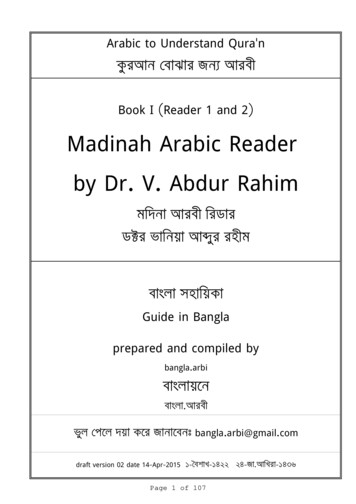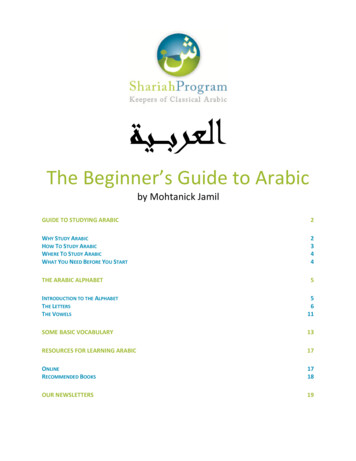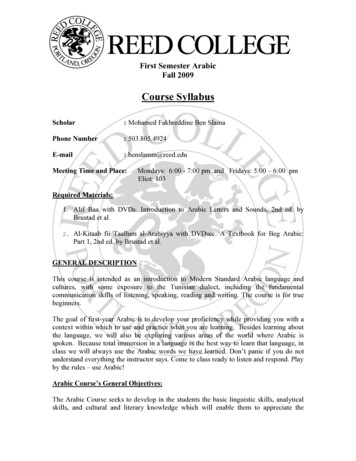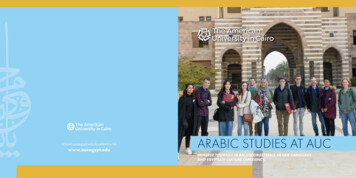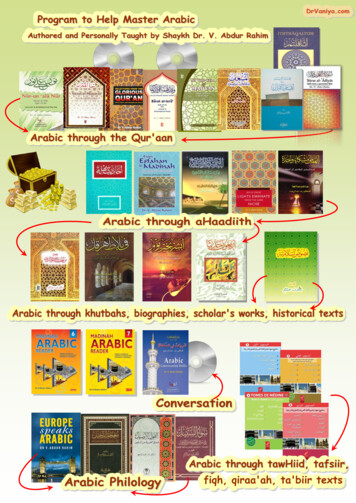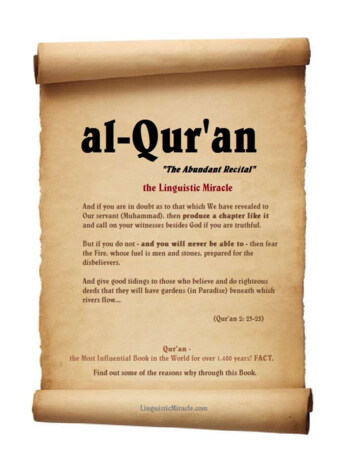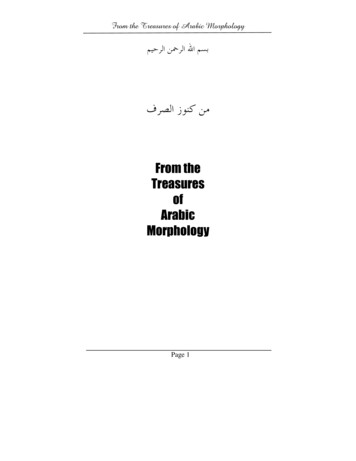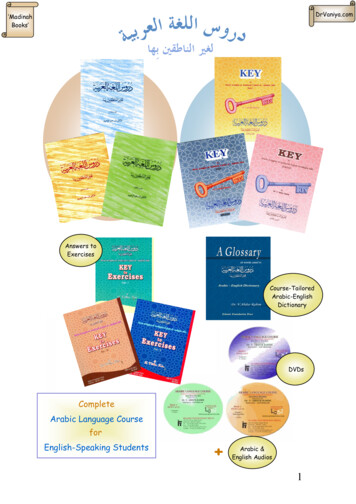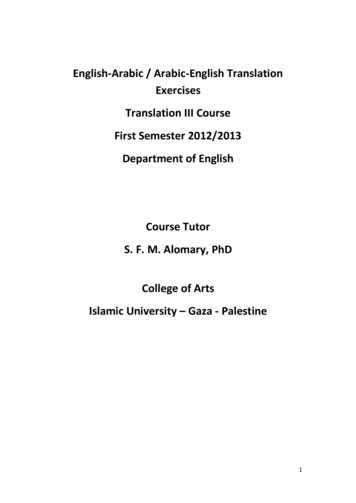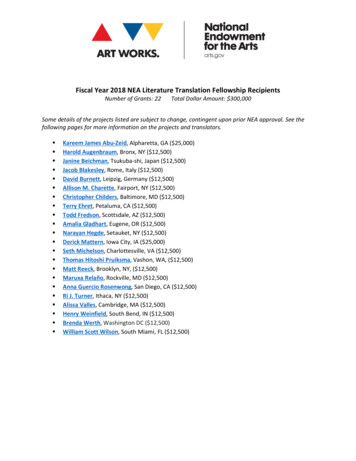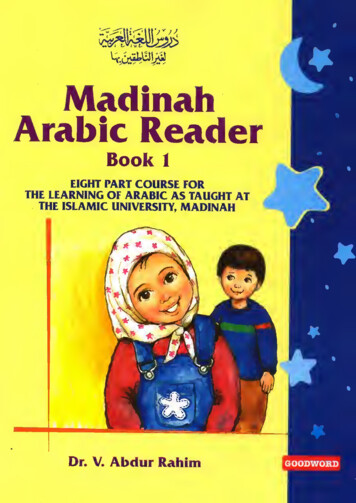
Transcription
i \\Vs*Jt' .w'ft-Vfvt. &m&MadinahArabic ReaderBook1COURSE FORTHE LEARNING OE ARABIC AS TAUGHT ATEIGHT PARTTHE ISLAMIC UNIVERSITY, MADINAHDr. V.Abdur Rahim
INTRODUCTIONFull-time Islamic schools are a relatively new phenomenon in the United States. However, thegrowth of such schools has been rapid and, Alhamdulillah, several hundred such schools now existand the number is expected to mushroom further in the coming years.admit students as young as 3 years of age (Pre-Kindergarten)the ensuing years, these students progress through Kindergarten, 1st Grade and all the waythrough 12th Grade, at which time, Insha Allah, they should be ready to enter college.In the United States, Islamic schoolsand,inIslamic schools curricula comprise secular subjects, which are generally the same as thosemandated by the County or the State for public schools. In addition, Islamic schools tutor religioussubjects such as Arabic, Islamic Studies and Qur'an. The standards to which students are tutoredand tested in secular subjects, on a grade-by-grade basis, are well documented so thatadministrators, teachers and students know, at the outset, what is expected in terms ofperformance from each party. Equally important, parents are aware of such expectations. Nosimilar standards exist for the religious component of Islamic schools' curricula.The Boardof Directors of the Nur-UI-Islam Academy, a fully-accredited Islamic school (Pre-Kthrough 12th grade) located in the Fort Lauderdale area of Florida, felt that the absence of welldocumented standards was not conducive to proper administration, teaching or learning. As a firststep to compensate for this shortcoming, the Board felt that there was an urgent need to structureand publish a series of textbooks that would fit well into the structure and overall curricula of theNur-UI-Islam Academy, and that may serve the needs of other schools in North America andelsewhere.This led the Academy's Board of Directors to invite Professor Abdur Rahim, Director of theTranslation Center of King Fahd Quran Printing Complex and former Professor of Arabic at theIslamic University of Madinah, Saudi Arabia to visit the Academy and to produce a series oftextbooks that would enable students to read, write and speak Arabic with some degree ofproficiency by the 8th Grade. Professor Abdur Rahim was both gracious and generous in hisresponse and traveled without delay to the Academy's campus to undertake the exercise. Hisefforts led to this eight-volume series catering for students from Kindergarten through 8th Grade.Professor Abdur Rahim's eight-volume texts allow the language to be acquired in the classicalstructural form. The books attempt to teach language skills through applied grammar. Each lessonconsists of a conversation based on certain language patterns. Various types of exercises help thestudent to understand each of the patterns occurring in the lesson, and to master them. Thevocabulary represents classical and Qur'anic words and expressions, along with words used inmodernArabic.Theseries of books are currently being utilized at the Academy to prepare students for theUniversity of London (UK) GCE Ordinary Level and Advanced Level examinations, via EdexcelInternational.The Boardof Directors, faculty, students and parents of the Nur-UI-Islam Academy are very muchindebted to Professor Abdur Rahim for his generosity and devotion to our cause, and we pray thatAllah rewards himinMaywho seek knowledge. Jazak AllahDr.Allah blessKemallabundance.HussainPresident: Nur-UI-IslamAcademyNur-UI-Islam Academy10600 SW 59th Street,Cooper City,Florida,USAKhairan.
MadinahArabic ReaderBook1COURSE FORTHE LEARNING OF ARABIC AS TAUGHT ATEIGHT PARTTHE ISLAMIC UNIVERSITY, MADINAHDr. V.Abdur RahimGOODWORDgoodwordbooks.com
CONTENTSLesson31Lesson 213Lesson 317Lesson 428Lesson 537Lesson 645Lesson 752Lesson 856Lesson 962Lesson 1072Goodword BooksI,Nizamuddin West Market, New Delhi-! 10 013E-mail: info@goodwordbooks.comIllustrated by GurmeetFirst published 2005Reprinted 2008Printed GoodwordinIndiaBooks 2008
LESSON ONEu- -.v— b Ijjb\k(j \JJbIJUfcijjfc & "/o,.il iJLft.IJL».jjj-4. iJiaL-iix*1JUa
mAli?- 3 u-?II
EXERCISE4Jjij?u"f-.U--s--u-1.I-'*" * " '"'»P*»'1i?I.J?u
Uft!? J IJLily yfcv IJl-a\6
oREAD AND WRITE .j*13 U*A .1ft*u5jljjlJTL1lJi fc.jjj-tIJ—fto1*?,IJL»? ijCr jIJlab---to* !*.IibUb8 0*» J—*\ U&c*Jf/JL.bIJUfc
i*\?\3\\/?!irijL-ft.Ja J IJL a— uj8c
J1.d\?U.lL o? lai«#j* J »UA
'EXERCISEjij.0READ AND WRITE'I.liie* IUft.LLk,jasta—A?UaUli* ? IJL-A ur u *i?»« »',*.'jfcj -ijla fno* ji10?aj*i *
POINTS TO REMEMBERweIn this lessonWhatThisislearn the following patterns:this?a book.ishouse?Is this a* ". Yes, thisNo, thisWhoisisisa house.a mosque.this?Note:pronounced J&, but1.ti*2.Arabic has no word corresponding to the Englishistitiswritten without thefirst alif.i.e.ArabicEnglish asin "this"is",has no copula.3.Thereisisno worda book".inArabic corresponding to "a"The n-soundbaitu-n, masjidu-n)isat theend of the Arabic nounTheparticle\(kitabu-n,the Arabic indefinite article corresponding tothe English "a"/ "an". This n-sound4.iniscalledtan win.placed at the beginning of a statement turnsitquestion, e.g.,Thisis.c4J l*&a house. JIs this ahouse?li0.\Minto a
Vocabulary:»-y»3JjhouseJoCJ k *v« mosqueboystudenti-*\JdoorJ*rjmanLi\s bookyrtfmerchant9 sptitJS'pendogir&L* keyiaiinLi »xjW?-writing Xi*roosterbed*i« X**j 5- 3shirtL J* doctor »j u teacherJjjl»kerchief
tfAej 'd*.iUiLESSON TWO3J#-Ji/*1L Atf*:iuij?y?3L*u-*- XCiJU313*,II L T Ciiii f
?Oil?dJ—Jili J" -aui—.; Jiu j143&u jIJLJ»jL.
oEXERCISEJij-0X04QREAD AND WRITE.fUjdlb&]&? &- liA ? IJUbajjj— U SoNew Wordsj"*-4J5120*11\"c- ujSitticV f h3 JUlif%olU&li lff15ls«
POINTS TO REMEMBERIn this lesson,welearn the use of LJimeaning"that",and j meaning"and", e.g.,Thisisahouse and thatisa mosque.A**** »*j iC ,J»*Note:1.2.dJJi ispronounced &Uti butThe word jisit iswritten withoutalif.written close to the following word.Vocabulary:jiUJimam xl» /v-stone0?16sugarmilk
LESSON THREE*//iJ :—c-J— r-JlU31if*:c.:».*—. jl* o\Jl" JC0317j Ij Jb ol Jl*
*-t ,I 0'.J* - "J,*L*JOs l JljL yS.3«-*sk*U*a* 18.i*-c J(
EXERCISES** * sO--o9Read and write each of the following wordsvocalizing.jUfJi.j%.ijliits last letter. kli ,oJj. .ir J J,4Tt(.»READ AND WRITE t r-.»wj-Uh rij[Jiwo oo(Y) o-. cr?.-;19 dij Iji'jfc\ ( V)
Complete each of the following sentencesusing one of the words given below:J *J»0)J 3j? *) r)0 O)JtfM* ( )&tSiix-:Fill*in; *»&jjilf * # J*Ui oifjifflo?&1 ( )the blank in each of the following sentenceswith a suitable word: j j 0) .a#hu* *).uSlj(t).!#(*)A)-W*(V) *03 * Jl i*.i?J&-(** 0200)(t)
*tNew Words SOj Jl oUKJl.-Jj t jj ?Ja.uL& :j/JCo J54*J— ?LJLJaJ!*»:.-.ij: J 1LJLJp«»«. . o 5,# #J T)A-*A'.J- . jsfli OtflllJ., (A).itdLwdi (O) p -l3l (V)aJuJUIrVfil ( )*1.Of*.J** &jf&lj tkfi L«Wt(U)21f
J**oRead and write each of the following wordsvocalizingM\.d )i,j&\,pk \,jp .odiJjjK.JCLjT.Jj#.jbjj jf.cdiij0 LJiUJ y) 5G1 (T):2 &Fill&. oUAS* eyJljjthe blank in each of the followingsentences with a suitable word:in,.'W last letteritsJ*** *)(*)O)22 tf - -J* 0)(T)( )
*-:(f)ttun*o i ayfli L uf (v) xj \ ur i - Match thefollowing: v 0)jjj.Lit j-OlTai?r\C UtJi*&\jiu*0-New words:tf* *rU Jl23- (r)
*0. t.The MoonJJ (0»\ i,»5 .,.:.:t,.n* »Oj** *Letter\i'"* :**o.i- lo «3 '«'I w-ajII:I.--*(Y)a (f):i: and the Sun Letters(1)ill-*\ *ft:UV-*( )t*a a'at o:* (V)tJ*(A)J(A;:g*(*)J(V:u (i *)iJu Ul:JOfjJL- SJluiI-ft": CJLJJ1:h (VV)JUjilJ-fcil:J —eHW*:JOf)(It)24(V:
EXERCISEc*j j&\ ft-*Jjij.jy a*iji& i iprij a iou&iReadthe following words and write them down bearingthe rule regarding the Sun and Moon Letters:O«3*1 c Z-j- cIfcL./.' \ : iA\.CJikJi.L d. yi. iii. ai iii25*.- -'. '"f.i#OinfjSimind
POINTS TO REMEMBERlearn the use of the Arabic definite article «al» whichweIn this lessonWhencorresponds to the English "the".to anoun naturally thethe definite article «al»indefinite article (-n)isisprefixeddropped, e.g.al-baitubaitu-nArabic has 28 letters. Of these 14 are called Solar Letters or Sun Letters,andthe14 are tionof the Solar Letters the tip or the blade of the tongueinvolved asinplay any partWhen«al»«al»ist,inisn,r,etc.s,Thethe blade of the tongue does nottip orthe articulation of the Lunar Letters asSolarthetoLetter,e.g.pronounced ash-shamsu. No change takes placeassimilationNo such(theisin b,w, m,k, etc.noun beginning with a Solar Letter the «l» ofprefixed to aassimilatedisindicated by the shaddah on theal-shamsinsun)(thewriting ( I JjJl).isTheof the noun.first letterassimilation takes place with the Lunar Letters, e.g. al-qamarumoon)ispronounced al-qamaru 0**Ji).Here are some more examples of the assimilation of the «l» of «al» to theSolar letters:al-najmubecomes an-najmual-rajulubecomes al-dikubecomes ad-diku al-samakubecomes as-samaku See the table of Lunar and SolarNote that the «a» of «al»isar-rajuluLetters.pronounced only whenisitnot preceded byanother word.Ifitispreceded by a wordin writing, e.g. al-baitu.it isdroppedHere the «a»by «wa» meaning "and" the «a»wa-l-baitu notTowaispronunciation, thoughpronounced, butif itdropped and the cate this omissionthe hamzah:isininpronunciation this sign «c4?tj26I»isplaced above
ThevowelinitialcalledhamazatuThe dooris(a,i,or u) whichisomittedwhen preceded byopen. -broken.isisl-wasl.yJu L Q\* 9The pena word/jjLSJ lullNote:Wehave learn that the tanwmtranslated as «a», e.g.u pii open", andthe indefiniteiscJj a house. This does not applyjjl iandarticle,it"broken".J* Sj\jj*A&*- j&richJ tallVcoldi«.poorphorthot- .-sittingstanding*bA?rnewold paperapplewaterbeautiful&shopsick27tobeto adjectives likeVocabulary: issweet
- ,cS ».J"osiLESSON FOUR - 1 {ti.fCUJl0)(V)*---oa-. U cJi -3 JjAuiP J* 'y*1Jajl28
EXERCISESAnswer the5&4)Vfollowing questions:——WSfc O) fl-s«o* Y)tanLji y (t-)» -tfo?(t) ?L *T (0)J L*Tftg&Ji tftl ft.( \)( v)f j it 3»(A)cl29
:oUl )1 jsMjfRead andwriteJ2 UST, oeach of the following words vocalizing\')\its(Y)lastletter: *.»o,«" / Jl Ipcxopo -i Jl 1pcc-iSMjloc oo.holt j*Read andflUktt Jowrite:.ysan j» p«i0,0--'.cJfrU Jl J f 5-»l .u.omjj(i)j * ai3JJ ( f) Jjjl(A)30J 1 *Lr-J !oJ?(V)
Consider the following:-JJ j (j*wl46 ,tO4oV l3-*si iiPJ4Read andwriteeach3fl, of the followingletter:31—»words vocalizingits*-lastII
(V)j ti ftj! (Ji-*:- I-wJ-* 1oil J j*», j,- «jjpfcjjt32x ' jjJi*4 ,-'Ja&s* tf6 ***6 *rf2:- o?.»* -f* J,** -taa s*
'Answer the-''-.,following questions: Read and write eachof the following*words vocalizingitslastletter:Read and*write:-t33-Qji jt , x
.*Fillinthe blankyys ""sOUUJl * oJ -j j /d\'ja**o & (V) each of the following sentences with ainsuitable preposition:(from-to-incjiLm t)j iii.-on)v ii*C ts i»«*, uJtjLwit.r/ (!)OtfdlNew Words.*wWlJUVr L*ai (V) * V** (*)Oft :tJ*"o.»-1 -Jli43 *31340)
POINTS TO REMEMBERweIn this lessonlearn the use of prepositions.willI.Arabic nouns have endings toThe normal ending(The houseA nounof anounshowtheir functions in the sentence.«-u'» as inisnew), al-baitu jadid-u-niswith the normal endingisc4?IJojS?said to bethe nominative case. Inin Arabicit iscalled\ j -After a preposition this endingal-bait-u (thel-bait-i (infichangesto: «-i» e.g.house)/the house)1»j,tBait-u-n (a house)bait-i-n (in afi9 ,io.house)al-maktab-u (the table)- r.*vala l-maktab-i (on the table)A noun preceded by j j\ iia prepositionissaid tobethe genitive casein(inArabic jj f* ).2. In this"she,lessonweallHeis inWhereIt isbeing,isisreferred to by the pronouna "he,it",and animal or aja whetherand [c—»the boy?p the book? - has a long-r-?.J -Butwhenit isfollowed by «al» the «T»long vowels are not followed by a consonant which has no vowel,35(filisu, f- *.,/!.p «?».denotes a the mosque.isitthing, e.g.on the table.The word—nouns are either masculine or feminine.A masculine nounWheretwo pronouns: jit".In Arabichumanalso learn the?,\,,*\,*shortened becausefil).inArabic
And a feminine nounhumandenotes aWhereSheIt isreferred to by thepronoun —»whether ythe house.i-»Jjthe watch?isitbeing, an animal or a thing, e.g.Aminah?isis inWhereis- {-.WfcllJl vf j, J - on the bed.Most feminine nouns end with a roundta («) but there aresome whichdo not have any ending.Note:1.Wehave learnt that the tanwinisthe indefinitearticle,—Je.g. c-—house. This rule does not apply to proper nouns. So -ut* "H mid", not "a Hamid".2.Feminine proper nouns have no tanwin, e.g. &*' co-yj c JpliVocabulary:jj'»«-/Ai pfU -la*4 «e * onwhere— rooms-UUlskybathroomJ- *Jlclassroom0/jp&yAskitchenIn36toiletisajust
LESSON FIVE ***««« J . .- -jIuJl* JS IjI.1j ji III:J uu:jp 'jky# ll j fo a o*** J»* Oi:V-: ip-*ui Ji ci%j a**; 37*j*t\ilp
:S #iAnswer the*L ,Slij* L-rf)following questions:«/*j* Vji-Ji***4 yfJl Jj iaSh1juf(r (t)Rewrite the two words in each group so that the secondword is in the possessive form:W srfs * O ,»t*JUl "y 0 (*i51« Jlfjll«pA AMIc'IIIUm JI M-i - lsT1c'-*i» ,COjj\ Sa.»-jjd-oit' ,**OjCLJlc7"ail ls » #f»Nv384JO**
roQSdlRead andwritelast letter ofj ljfJa Li ij y«(r each of the following phrases vocalizing theboth the words:**- .j*oiisis J&Read:« 'J—.». ow *J. 1l'.'l- oftr - " uJl--".*),»„*y (V) 5 (A)' J1(i)c4i IjSf (fill * ffi c 'j vJ4 jlU"c4j
Ji\sf-. jUl. dl Ulllrttj4l»3 M J1Iju- jluJl ,j***a tUJl L*U*.f jUJl: JJUJMake sentences by filling.X*Jv tyjJljJ* - Lp*Jij 3xii U -5j\lJOjT (0the blanks:—3? * &C-**in 11,1. ic4J»(1(*)1J- 3.**H&*UIp-.jjL& oJlkJl' tlji UJi**(A)'*' 'ja jwUJiti jry*'vis* oi ii (o(\)4( )40.J \tff(VU)
Correct the following phrases:6our ii -fe i):9iai)U-Jl cJboJt-kjijUiaik jjLj\6cfS cH!afjii iiii.»is a 6 x.* U w« b:.4ju**-«(V). *Read andwriteeach of the following nouns using the correctending:.*»*.* 4»!St # # «J , *-'Readthe following example, then make similar questions withreference to the following pictures:?y?,41a l,ljt
V JJuJl*-** !U.ixab»-ssfsRead the following sentences bearingin ij uJl* «ul**«*ymind the,rule ofhamzat-al-wasl. ufil A*tf" j dBjrf *wk- i (\)».Xc43« j*c- lail }lr- XTJ* *U.j jiiNew words:VI-- ci51ti'JUL iin*-**42(Y)#tstfcJfli( )y y«( \)
POINTS TO REMEMBERIn this lessonwebook1. Bilal'slearn the following:abu(kitJ j LitfBilal-i-n)*The imam's house(bait-u l-imam-i)In J* w»lsT the firstIt isthe thing possessed.is %The second wordcalled mudaf.mudafwordfa.U)Pisthe possessor.It iscalled ilaihi.Note:mudaf takesthat thea)article.Somudafiswrongisitneither the definitelWto say— %L lsnor the indefiniteTheor J*A; wJls Jl.by position, and does not need the definitedefinitearticle.b)themudafthefirstilaihi is inthe genitive case.example or Jl asItcan have tanwin asthe second example.inBilal-u-nbait-u Bilal-i-n%al-imam-uc) ?j— caseindicateitsisit ,.bait-u l-imam-iL ll f "whose book?". Notebecauseinindeclinable,that J*i.e.itisnotinthe genitivedoes not change toThere are some indeclinable nounsfunction.inArabic which remain unchanged.d)j*jM\ J.— J—*. Note **because of the prepositioncase because2.c9xj"under".itismudafThe nouno3.tf isilaihi:t-Jl oicJ*ja vocative particle.iisinJ—f-'and j*j&\the genitive caseis inthe genitiveilaihi.following C*?%Jomudafthat -ix*is inthe genitive becauseaT*s *}\ ci% iA nounfollowing43\jhas only one dammah:itis
& *{ U c v U J* b not J* betc.44.The wordsjU*tby a word theandinitialj *«i-».SiiTcommenceisdroppedcijlllitjintJ tv4? ibn-u l-mudarris-i tab?b-u-nWhen precededi}Sl jU-il-bint-i j-U wa bn-uaina bn-u hamid-i-n?l-wasl.pronunciation.wa sm-uism-u l-walad-i bilal-u-n,.yrb" *U)II jjljhamzatuwithaminat-uJ )l-imam-i tajir-u-n.? j &)Vocabulary:Jj**J\under, beneathThe messenger a!I jUJi&&1paternal unclestreetThe KabbahJt lmaternal unclejj&«closed, shut* yOi-i». JVlson3jCJ carlift UacJJli Jainamebag, case44lheretheredaughter,doctorgirl
jrfdl-J! jJIILESSON SIX6X«u8lj j--\jci/j -J r -u -TtJLO*9S **?jj!,*of *i. *.'?dlj j dJL45jfc
A Jf iJA '.'* o.jJiJ!a Jp 4pL»aJLa * Ij r 4JL»ir jbJ ** %;(2. *.ojJ tfAUJl * *tHx.jJU dJJtj 4ikU 0JU6» -o.» * UJi oyij oJLa.46j-P«JtftjOilOJLflJ
*!*/READ AND WRITEUhI*s*, **J** *». r.U.,J jiX \»j uJi C-iJ oJjt j cr*%! 1 fftf s'Ji\ IJLft( ).A -lsri oJLftjjM i? (%)j-»b.EXERCISES:ajl jj fo*(f)AAA (O)(V)jjUib STj JtftJl fjl (t)this pattern:&J* L J? ! & (t). 4Li J iMtiSi47»1Ijj*3Jil» eJLftj w/\J IJLaRead the example and make sentences on%?'ULi.JUi L»dijwjr( i)Jj -Ji (O)
.3j aJifjuu a luJi (V).biyi i .*sLJlkJl (A)** »:hfi\J Jlwv#-(I )Correct the following sentences:a.48/.„ ?» tu. jSAa j il (Y)OjU-JIry&* AAA (i)
j-juji: letterofall,arj&\ 'J (O)oUJ Ji j*\'J Ja ii Lirij Hi (t) " Read andj /9»*write the following sentences vocalizing thelastnouns:.*u JC*JU3j. J J xjlj(jj&ftjl(Y)4i)(t)bQ&,»ji&r-Jla (1IkJl (f):ft*jfe)1'1j--\J oiA ? oaja [ J.New words:.WwU. JfVt5 1siiL-Di49
POINTS TO REMEMBERweIn this lesson1.aJ a whichomittedThis2.isinlearn:the feminine of Ui.isIt ispronounced oil* but thewriting.a boy and thisisagirl.djjbj oJjNouns and adjectives are made feminine by adding a « »Thelast letterbefore this(5)takes a fathahmudarris-a-t-u-n(teacher)(lady teacher)MsonnounsdaughtersisterArabic are either masculine or feminine. Feminine nouns andinadjectives usually have the 3-ending. But there arenot have this ending. Studentsgenderat the end.a separate form for feminine e.g.,brotherAlla mudarris-u-nSome nouns haveIj(a.).2, *.JValif iswhenlearning asome words which donew noun mustlearnitsalso.Double members of the body are usually feminine while single membersare masculine, e.g.erninineMasculine*%handt/ljheadJ J'egca »noseC&* UQS\eyep*ear rjJj50mouthface
3.Jisa preposition meaning "belongs to, for" e.g.,This belongs toand that belongsBilaltoHamid. lnJCtlii)Praise belongs to Allahalif.No lam needlillah-ito be[ J means "whose" or "belonging o the word.e.g.,belong to?J"also", e.g.isalso beautiful.i r means "very",Thislui-lbeautiful,and that5.JUfcthe book?meansisI(belonging to Allah) by justNote that J» becomes J» when followed bys4. UajiJ*yU. UJNote that the word aDi becomes *Udroppoing thec.J4 r UaJl dUi)e.g.very big.i r51 - lJ&
LESSON SEVEN?0J4ft,y i«l OJLftXXXxx**. .a-« do JA-Py*A«CJs» OJLftxxxxob;di 3* ids} j *ji *U.X.X» /,Oj aiOIII**--*u 0/dbj»aJU Jpxflj.JA52kj«& Xoja-*xU"\JLftilb t
teJULrU".jjaji o ul-ClAL"j jjjjt»S*oJLftW*f. oLPMX.cJUl -.ftitfJaS9IfoJuU&CfliAcV&Ui.*** - dJJij4 3 »0&( )sJ rlift(i)&b} LOT\jj (\)iiLtfj1rjfyO)5 5J dJLLfj jUj - (HJ3 (Y)(# »I*iJUjj iJbiwrite:«*a C1-4 U Uj*4MRead anda* — « *.yib.jie-di53dli j 4l*jai aJLa (O)« j - diL-3 alliJicjliftfVi
:(oii4Ui)the blankFill in J& 330.1 *l b 2 1 olUSfteachinof the followingJl f(t)sentences with t*U orovU:#***(?)ViO) ? f0):mXMo);&(O)2ui*L (t) *),j&(A)&\j(\ Y).c-ixi( )*„* ***.*ijfij**( 0)sjifc( A)53 ! ,jtoH * '0*)»&j*.-a jb-(W -2(X )hi Jfc ijii **0?) J*r-0 (J-*13*o i(SJLbFillinthe blankineach(V).J****( n jj f ( V)illi) jljOJof the sentences in Exercise 2 with d-Uior ilte54
New words:t*isssik3ia g'o jj I'pty* *""'jiBi' »is.*** * iUi3ulIdJjtJJ*\POINTS TO REMEMBERIn this lessonThisis Bilalwelearn dii» whichand thatisisthe feminine of&J "that" e.g.,Hamid.JU&- CUiijThisisAminah andthatiscJ* \jl&Maryam.' Xti'j crtlaT QJJb.*ij*Vocabulary:&3ishe-camel iducknurse55Aj J1eggJij«jlmuirWlhen'adhdhin
tiLESSON EIGHT.L4 jj ji,wU»o "w«JaJ)&jy, tf jir j »l(t- 'J j-o - .yjill c43l dJdi} r&J V--SS yocd»ii**-» TJlaS--J!NEXERCISESAnswer thefollowing questions? \3lainB*! ITT-&:5611.1U( Y)
Read and*' - **.--write:j «/ijJejtll&(t)cl r « illift(T)u- f J*j» t«Wj j*U1 Lj L i Ji Jj*}" *rjiii - '.* i. "- o ?oii ( )Odt LU(O)&d\ «Jla vj(n -t J }iif ; J 53CJI V? iu cdiL*? m#\ S 'iii jiU). U J c p&. ila.- U6J ilL-j.IjM (T)diL-3eV?3*1*coudicdlii*ffliAi(V)( A)ilJSf 33CJ1ojla ()nORead the example then change thefollowing sentencesonitspattern:.u Jj L u ji iju &i).570jL-» 6JA (Y)
jOjl lsj y* O*.4PCL C*! .0S}J.5}«r.oJUb(V)JjjlL» iJla(A)c/J**»-*** **' «*(t)jU liA (0). & .C*JUL»e -** eSS"Read the following example, then make questions andanswers onitspattern:? yS3l-*(iik*p:Jtt.-(JV)0)( )(t)M (jjxUi)f(*)(C ' )(J (T)(*)1)O -*)1(V)58
0%(viui).(A)Me.(H)(UiLii)0')3 -;to *'„:*-?i\ ibi i jj(j (0)Readcarefully the followingexamples:SM »V ' -'ji ajiuyiji ,»t)3&osionc rmmm, ,r „9i jj. V»M fiffb* Ui QQt5.8 y 1 &PPi .0. 0Jl((J 8 D im.'"'.7/.' L"«*. jiJ.'write:M OHjinna * : : .»' , »ixiyiJjouii JiRead and Jt wVw gJiL i )i"159*&I&3 4- j,-,-Ois3"iijUb*
Read:»- oo.jk ioii Life fU?i c4J fftiyi ci; jjI * .ijiki(f*-uU jj-i r jjIcrJir fJUfc-(i)POINTS TO REMEMBERweIn this lesson1.Howmeanslearn:to say "this book""thisbook". Thisa book".isNow wenot a sentence. Toispredicate e.g., "this bookAllArabic.inisWelearn that oliSJi \Xkmakemanisitmake.isbeautiful.That nurseisfrom Japan.2.We"thisa iJ*.Wua-mIJUUl«jJr\j\dU3aJ.Xthis construction, e.g.,an engineer.This watchmeansIwe must adda sentencenew" t r L Jldemonstrative pronouns can be used toThathave seen that L UToa & UJl dU;have seen that the normal ending of a noun is «-u», and itchanges to «-i» after prepositions, and when the noun is apossessor, e.g.The houseBilal is inThisisisbeautiful.the house.the key of the house.60
Nounsending inunchanged, ca.l ty»lIamHeisfrom Americathe president of Americao,,UI 3.AAA"behind",fU?"in front of".The nounafter thesehave«-i»ending e.g.The houseHamidisofront of the teacher.is inHamidbehind the mosque.is infront of the teacher. 4.Lrlpr means "heWheredidHe satinsat".Muhammadsit?front of the teacher.Vocabulary:l jylji**H AmericaandIraq/ «?Switzerland *final t isknifeUwJt GermanyclosedNote that theis fi,0 -* whichispronounced'a/a.61 IjsISwjEnglandHhospital» *alifhas no dots. SoJ
all j —IILESSON NINE(')1».J.-JjJ&?1 OJjJJI, »i«i \i ?CL62*ij J* kUlr*i» * * bii!jl\hu
*0.CJiof4?EXERCISESRead anda**ui cjffl&-C"'. 'f J j CJ.V«"63 -.Ijit (I)(V)( LT-J CJfl (A)'j J CJlt }af-iVaTljwrite:
soOFill inthe blankineach of the following sentences with asuitable adjective:i?& %h& tf oJ& (Y) y&& al Sijjkeft ( 1*-- jX*AaJ."iliXfi: -.(* \Ijm;the blanksuitable j*- :Fillinin45Ul (*V)l #fy J sJieachJ JWi &Jl J k (T)of the followingsentences with a& i 0).al * * ?). *J.-XJ a3 ( d ).cftCTReadJiV? Uxll (O)LJlk cJu (S)liA(4)llfa))tjb\&\ ( jj & OOJaP13r --J* JU ti (V) (t)-*(tijJ&jW (A)j*JiJ( )x::f Jl (i)eOlP r cJff (Y)64.&&j*111( )
.9fNew words::3iJ - yM D -JLTO L oi0L * :t.hfc4 ft*JJ-&a*JIdi—::*'*(V) J ' J .65jjjuji alpji
4 «1-\\l4*a»XX*-' Qgp-XXX X.- ;-» *»»- jEXERCISE-*JL*U".0Read and*i9i(i)write:xO,8xX«»X1 ""x xxXX**x!«x xxa66iJ\ 'jM\ Jfr LJ»i ( v.dip Itf-x- xXX " *xXX.jejjJl* X'J& iiUi(5
u*J O* uL*i out j* OJithe blankadjective givenFill in1J** **c Jb Jb UJJljfo* fJJt(1each of the following sentences with theinbrackets.AddJlnecessary: r &itfO)J-6»f )if-Jj-* t* iCJi.( )(lair) .*u iU -ti SGi cT)in(S**)* «U» J*CJikJi(t)uf (?) J (t) j* ) y iiifc itiyt (0) * Xj'jteO)&&)sJ 2w» V)6 *&)*ipia* - (A)eq &) h*& *)?67pi(xk ( *)Sfc*ii(oo53C-JI di* J(1 1)
Read:0")'J-*XXJt.v&dt j*X fjs\X -XX j jjt lift— " x !!—x# xvulii»„,,** "x( r .-XXX*Read the example, then make sentences onitspattern: 0)00l»xifJia iJ *f i/O"**. Aill(?)ciJ( f*yV*bJ —Sfi4mi68i)oJax
POINTS TO REMEMBERPartweIn this iessonlearn:The adjective1.ATheArabic.inqualifies, i.e. unlike in Englishadjective in Arabic follows theitcomes*l»a -In Arabic the adjectiveiscalled na't (cJJ),man'ut(CJ ). Thecalleditafter the noun, e.g.,A new houseisnounadjectiveand the nounitqualifiesagreement with the nounis ininthe following matters:Thea) Gender.adjective of a masculinenounof a feminine*. isnounmasculine, and thatisfeminine, e.g.,**.{'a small boya smallnew bookaa 'new carb) Being definite or indefinite. If theAndalso definite.girlifthe nounisnounisdefinite the adjectiveindefinite so alsoisthe adjective,e.g.,newaBilal isteacher.The new teacheris intheclass.« c)TheCase.ThisIamisainadjectivenewais inthesame case as theman'ut, e.g.,1 house, (bait-u-n jadid-u-n)newhouse,(fic-i; {jj*j»frJci'- .sr;bait-i-n jadid-i-'n)isbeautiful,(al-bait-uI-*U *jadid-u)Whobi,The new houseisjja ileJPl inthenew house?(fil-balt-1I- jujl Ji c*3 1'J\jadid-i)69;is"\iJ fcTsT
2.Adjectives endingd% Sin«-an» have no tanwin,e.g.kaslan-u (lazy)d&yr jau'anu(hungry)dCiiaP atshan-u(thirsty)dCb*ghadban-u (angry)l mal'an-u(full)Vocabulary:i UJlEnglish (language)fruit* uageft» todayeasybUJ whylp?«-aj# &jllbirdSaiJtS&difficult0 )lhardworkingcupfamousPartBIn this part1.weAdjective qualifying a definite noun, e.g.,where2.learn:isthenew teacher—Relative pronoun c Jtranslated "who",andIf»«if ititrefers to arefers tohumanbeingitistoan animal or a thing "which",.j&b tf 0Y» o*UJl70'ja il j* lbee.g.
The man who went outof themosquejustnowfamousaismerchant.*The house which3.Note that whenJis inisfront of themosque belongsto theused with a noun having Jl, the9imam.alifof Jlis-omitted:4. Itf- "with".The teacherThe nounfollowingithas «-i» endinge.g.,fiswith the headmaster.ItpVocabulary:library6 lStiinow, just nowjijjpl***thereministersharpoJ *yL \**-j Jlfclinic,JjiJtsmall hospitalfan -JjMmarketIndonesia9,JjxJl j&JlKuwait71streetJfiiJi
oAtflVJUlLESSON TEN*1 1* 6 sI*? U» jJl ya2lXff»tj&* * '*Ji// ij :! *- ".s» 72* jA " tf »s .OUU!* * *t kfj«V t:j w**xJ
u «i.*.djjiiJl 4J*UJI ,-9UA,-** jAjt4*U 1*am a .*« U*» 1 cJL -ijpi .Jfifd»j«H (V l J V- J itJ4i«731 fr*-"»u?b»tm a.*-*J*s.tfJZp hjj- rjj *-!**:s:JU u*IW 'J **'---JJ
oEXERCISEjij.A'ft\ L f*LcJi\sAnswer the y( \following questions:tCJI #1 (Y)j* -tlJJ?fil»i& *?3?( )jMdfStlU(V)U(f)aJf (i)liaLpftOl(A)Jr.s5 «.&LJ1 ( V)t*ac b*0?)i? flj ?4„4 ,»«A) o U(1A) of„ / J ,/J JJT f t)74 »?j l(Vd)
Fill inthe blanksuitableeach of the following sentences with theinpronoun(li / «): HO— i -50 * **- -if j j**—s*\j*- -*,0a?U» ciJi dii.U j0 ( Y)& r *ut(t &J&( ).*?*J!*'i&'aSytfi« "CJp—Vj ** e/*j J-**' cr* y- o Make five questions with.' oComplete thei-r'w* *.followingr*.to*"oons'ou»» -»this pattern: *answers ontheir;Uj oSpranswers ontheir Make five questions with o*«*this pattern cV?jui ftfef*. --sthis pattern:''. \.\*75 'OS»*»
Read:With:
.jj4*I1*i 1/jXcA\ [jJsr (T).?s fiSs s sA*As #J*J*ft***'S AAA*p' *\ gj» l -jj l o0 li.«.»», /*r*vi"l s4 ".CUJl 0* U*I % *(A);f :Us f21jM:ri f . f * *Alb*, ,:la ijf77(\)0 fl(0)*U*«-o( )IJa 0 V i**Ul»ty tyl
Read the following proper names vocalizing thelast letter ineachof them:New words::3ajO JlolUSjlPOINTS TO REMEMBERIn the lesson1.welearn:The possessive pronouns:kitab-u-ka(your*,&, '25,Herebook)."your"foris JjIsS*masculine singularkitab-u-hu (his book)" kitab-u-ha (her book)0gkitab-i- for kitab-u-i(my book)These pronouns are not »full-fledgedwords.They arelikesuffixesattached to the nouns.2.Aswe haveseen "your book"*The wordfor "father""Your brother"An extrailaihi.wawIn theisisisiblsT and"his*iV' andbook"for "brother"SJjtf (akhu-ka) and not&&fis*j&'.isfr),(akhuka).j has to be added between the mudaf and the mudafsame way"his father"is78notajI(abuhu) butijfi(abuhu).
Note the following:/"Muhammad's house""Muhammad'sButisfather"0.Us*father"*Us*j isAnd "Muhammad's brother""MytCw*U*w«is/fy\-U W.and "my brother" have no extra waw,The nouns which takethis extrawaw whene.g. d\kuA.they are mudaf arefour words. You have learnt two, and you will learn the othertwofutureinm\ *&d\.yWe3.have already learnt that the word meaning "with"to convey the idea of "to have" e.g., ?jii Q'jL(literally, "IsWe4.itisto you", i)also used"Have you a pen?"there a pen with you?")have already learnt the prepositionWhen*\isattached to the pronouns"belongs to him",itJ meaning"belonging to"takes fathah (J):dU"belongs "belongs to her"; but J "belonging tome", has kasrah.Note: } J means"Ihave a brother",literally"a brother belongs to me."sj»3 means "with"It iswrongto sayIhave mouth"literally"amouth belongsjM t 4«WjU c -u p because ' *istome."used with thingswhich are separable, and relations and parts of the body are not ofthisnature.5.Wehave learntL* ai(masculine singular) and"he went".c * "INow welearnC-I—ai "you went"went" (both masculine and feminine).&yxj\Did you go to school today? JlrfJ\Yes,Ic V went.79tljo
f6.Wehave learnt that feminine proper nouns have no tanwine.g.-0t *4j— u*iLikewise, masculine proper7. —Means*rememberwith.thatifnouns withTo understand thegone—jis' J*»difference* ' *with the headmaster"to the headmaster's office, .uilending also have no tanwin, e.g.between and &-you say;* i."The teacher3-\.meansitand heisthat the teacher haswith him there, butdoesn't have this restriction.He can be j-UJiwith theheadmaster anywhere.Note that the noun after i has «-i» ending.8. 4*a\irJb "atthe university".Note that V)y \ AluuJU- &%S \isa preposition meaning u*li-lmeanswat"uin"."Islamic University atMadinah Munawwarah".9. Inlesson 1we haveused as a negativeVcar',Ihave nolearnt thatparticle,soU means 'what'. This word is also.5jL* jIp Umeans 1 don't havecar'.colleague, classmate J young man j)Jthusbandi -ljJAJ1childJr 180onea
600DW0RDwww.goodwordbooks.comGames andPuzzlesThe Holy QuranTranslated by Abdullah Yusuf AllQuranQur Challenge"-100MiTrie—HolyQuran- The Quranisthe greatestblessing of Allah sent tomankind. Let usinparticipatethe dissemination of themessageallChildren'sallof theQurantoof humanity.BooksGoodwordIslamic Studies(Grade 1-10) ',\
MadinahArabic ReaderBookrProfessor Abdur Rahimis1the Director of the TranslationCentre of the King Fahd Quran P
Madinah ArabicReader Book1 EIGHTPARTCOURSEFOR THELEARNINGOFARABICASTAUGHTAT THEISLAMICUNIVERSITY,MADINAH Dr.V.AbdurRahim GOODWORD goodwordbooks.com. CONTENTS Lesson1 3 Lesson2 13 Lesson3 17 Less
